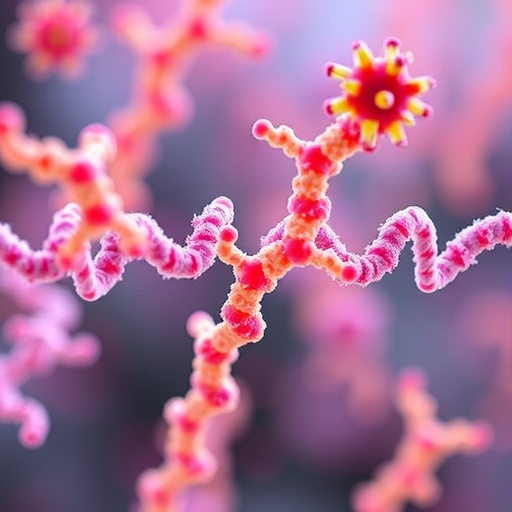Bacteria possess extraordinary capabilities that ensure their survival and adaptability across diverse and often hostile environments. Central to these capabilities are their motility structures, the flagella and pili, which not only facilitate movement but also play an essential role in the exchange of genetic material. These motility organs are much more than mere appendages; they orchestrate critical processes such as colonization, biofilm formation, and the horizontal transfer of DNA, thereby driving bacterial evolution and pathogenicity.
Recent groundbreaking research spearheaded by scientists from Heinrich Heine University Düsseldorf (HHU), the University of Tübingen, along with contributions from Gießen University, Freiburg University, the Max Planck Institute for Biology Tübingen, the US National Institutes of Health, and the New Jersey Medical School, has brought to light a previously uncharacterized family of signaling proteins. These proteins are ubiquitously distributed throughout the bacterial kingdom and are pivotal in regulating the dynamic behavior of bacterial motility mechanisms and DNA uptake.
Published in the prestigious journals Cell Discovery and Proceedings of the National Academy of Sciences (PNAS), this research elucidates the intricate molecular dialogue governed by second messenger molecules, specifically the cyclic dinucleotides c-di-GMP and c-di-AMP. At the heart of this regulatory nexus lies the newly identified receptor protein ComFB. This receptor mediates the bacterial response to cyclic dinucleotides, thereby finely tuning both motility and DNA competence processes. The findings underscore the sophistication of bacterial intracellular signaling networks and their evolutionary conservation.
The discovery of ComFB reveals a versatile mechanism through which bacteria perceive and integrate environmental and cellular signals. This receptor protein’s ability to bind both c-di-GMP and c-di-AMP with high specificity indicates a dual regulatory role, modulating flagellar and pilus activity as well as the uptake of extracellular DNA — a process known as natural competence. Natural competence is vital for genetic diversity and horizontal gene transfer, allowing bacteria to quickly adapt to new stressors such as antibiotics, thereby exacerbating the challenge of antimicrobial resistance.
PhD student Sherihan Samir, leading the experimental investigations, highlights that the ComFB proteins from cyanobacteria, Bacillus subtilis, and the notorious pathogen Vibrio cholerae demonstrate remarkable precision in sensing second messenger molecules and translating these signals into functional changes in bacterial behavior. This interplay represents a paradigm shift in our understanding of how bacteria coordinate complex physiological functions using minimalistic molecular tools.
Professor Khaled Selim, the principal investigator, explains that c-di-AMP belongs to a novel class of cyclic dinucleotide second messengers whose roles had remained largely elusive until now. Their research successfully connects c-di-AMP signaling with the regulation of natural competence, mediated by ComFB proteins. This regulatory axis not only governs motility but also impacts the integration of foreign DNA into bacterial genomes, influencing traits such as virulence and resistance.
Understanding bacterial natural competence through the lens of ComFB and cyclic dinucleotide signaling has profound implications. The capacity for bacteria to uptake and incorporate genetic material facilitates rapid genetic diversification, offering a survival advantage in fluctuating environments. Moreover, it accentuates the threat posed by multi-drug resistant bacteria, as genes conferring resistance can disseminate swiftly across bacterial populations and species boundaries via competence-driven DNA uptake.
The breadth of bacteria employing this signaling mechanism remains an open question. Researchers are keen to explore whether clinically significant pathogens utilize ComFB-mediated signaling pathways. Such insights could herald novel antimicrobial strategies, targeting the molecular machinery of bacterial competence and motility, thereby mitigating the spread of antibiotic resistance.
The contractile pilus machinery, a critical motility organelle involved in DNA uptake, is evidently regulated by ComFB in response to cyclic dinucleotides. Visualization and structural studies, enhanced by innovative AI-generated imaging, have elucidated the conformational dynamics underpinning this mechanism. This detailed molecular understanding paves the way for targeted interventions that disrupt pathogenic bacterial communication and movement.
Furthermore, the interdisciplinary collaboration across multiple universities and research institutions underscores the complexity and significance of this discovery. Integrating microbiology, biochemistry, structural biology, and advanced imaging techniques, the research exemplifies how multidisciplinary efforts can unravel fundamental biological processes with far-reaching implications.
As scientific inquiry advances, the potential to exploit second messenger systems like c-di-AMP and c-di-GMP in clinical settings becomes increasingly tangible. By manipulating bacterial signaling pathways, it may become feasible to attenuate virulence, inhibit DNA uptake, and ultimately stem the tide of antibiotic resistance — one of the most pressing global health challenges of the 21st century.
These findings not only deepen our molecular comprehension of bacterial adaptability and pathogenicity but also open new horizons for translational research. The identification of ComFB as a central node in bacterial signal transduction emphasizes the intricate balance between motility and genetic exchange, a balance that sustains bacterial evolution and ecological success.
In conclusion, this seminal work expands the frontier of bacterial cell biology, spotlighting the intricate signaling mechanisms that govern critical aspects of bacterial life. As researchers continue to probe the depths of microbial communication and competence, the insights gained from the ComFB-cyclic dinucleotide axis promise to inspire innovative therapeutic strategies and enhance our ability to combat infectious diseases effectively.
Subject of Research: Regulation of bacterial motility and DNA uptake by cyclic dinucleotide second messengers via the ComFB receptor protein.
Article Title: ComFB, a new widespread family of c-di-NMP receptor proteins
News Publication Date: 18-Sep-2025
Web References:
References:
Samir S, Elshereef AA, Alva V, et al. ComFB, a new widespread family of c-di-NMP receptor proteins. Proc Natl Acad Sci USA. 2025;122(38).
Samir S, Doello S, Enkerlin AM, et al. The second messenger c-di-AMP controls natural competence via ComFB signaling protein. Cell Discov. 2025;11(65).
Image Credits: HHU / Khaled Selim
Keywords: Cellular physiology, Flagella, Cyclic dinucleotides, Bacterial motility, DNA uptake, Natural competence, Antibiotic resistance, Signal transduction, ComFB receptor, c-di-GMP, c-di-AMP, Bacterial pathogenicity




